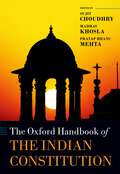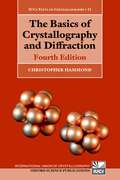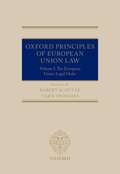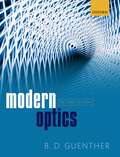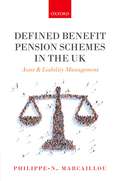- Table View
- List View
The Oxford Handbook of the Indian Constitution (Oxford Handbooks)
The Indian Constitution is one of the world's longest and most important political texts. Its birth, over six decades ago, signalled the arrival of the first major post-colonial constitution and the world's largest and arguably most daring democratic experiment. Apart from greater domestic focus on the Constitution and the institutional role of the Supreme Court within India's democratic framework, recent years have also witnessed enormous comparative interest in India's constitutional experiment. The Oxford Handbook of the Indian Constitution is a wide-ranging, analytical reflection on the major themes and debates that surround India's Constitution. The Handbook provides a comprehensive account of the developments and doctrinal features of India's Constitution, as well as articulating frameworks and methodological approaches through which studies of Indian constitutionalism, and constitutionalism more generally, might proceed. Its contributions range from rigorous, legal studies of provisions within the text to reflections upon historical trends and social practices. As such the Handbook is an essential reference point not merely for Indian and comparative constitutional scholars, but for students of Indian democracy more generally.
The Oxford Handbook of the Indian Constitution (Oxford Handbooks)
by Sujit Choudhry, Madhav Khosla and Pratap Bhanu MehtaThe Indian Constitution is one of the world's longest and most important political texts. Its birth, over six decades ago, signalled the arrival of the first major post-colonial constitution and the world's largest and arguably most daring democratic experiment. Apart from greater domestic focus on the Constitution and the institutional role of the Supreme Court within India's democratic framework, recent years have also witnessed enormous comparative interest in India's constitutional experiment. The Oxford Handbook of the Indian Constitution is a wide-ranging, analytical reflection on the major themes and debates that surround India's Constitution. The Handbook provides a comprehensive account of the developments and doctrinal features of India's Constitution, as well as articulating frameworks and methodological approaches through which studies of Indian constitutionalism, and constitutionalism more generally, might proceed. Its contributions range from rigorous, legal studies of provisions within the text to reflections upon historical trends and social practices. As such the Handbook is an essential reference point not merely for Indian and comparative constitutional scholars, but for students of Indian democracy more generally.
The End of Outrage: Post-Famine Adjustment in Rural Ireland
by Breandán Mac SuibhneSouth-west Donegal, Ireland, June 1856. From the time that the blight first came on the potatoes in 1845, armed and masked men dubbed Molly Maguires had been raiding the houses of people deemed to be taking advantage of the rural poor. On some occasions, they represented themselves as 'Molly's Sons', sent by their mother, to carry out justice; on others, a man attired as a woman, introducing 'herself' as Molly Maguire, demanding redress for wrongs inflicted on her children. The raiders might stipulate the maximum price at which provisions were to be sold, warn against the eviction of tenants, or demand that an evicted family be reinstated to their holding. People who refused to meet their demands were often viciously beaten and, in some instances, killed — offences that the Constabulary classified as 'outrages'. Catholic clergymen regularly denounced the Mollies and in 1853, the district was proclaimed under the Crime and Outrage (Ireland) Act. Yet the 'outrages' continued. Then, in 1856, Patrick McGlynn, a young schoolmaster, suddenly turned informer on the Mollies, precipitating dozens of arrests. Here, a history of McGlynn's informing, backlit by episodes over the previous two decades, sheds light on that wave of outrage, its origins and outcomes, the meaning and the memory of it. More specifically, it illuminates the end of 'outrage' — the shifting objectives of those who engaged in it, and also how, after hunger faded and disease abated, tensions emerged in the Molly Maguires, when one element sought to curtail such activity, while another sought, unsuccessfully, to expand it. And in that contention, when the opportunities of post-Famine society were coming into view, one glimpses the end, or at least an ebbing, of outrage — in the everyday sense of moral indignation — at the fate of the rural poor. But, at heart, The End of Outrage is about contention among neighbours — a family that rose from the ashes of a mode of living, those consumed in the conflagration, and those who lost much but not all. Ultimately, the concern is how the poor themselves came to terms with their loss: how their own outrage at what had been done unto them and their forbears lost malignancy, and eventually ended. The author being a native of the small community that is the focus of The End of Outrage makes it an extraordinarily intimate and absorbing history.
The End of Outrage: Post-Famine Adjustment in Rural Ireland
by Breandán Mac SuibhneSouth-west Donegal, Ireland, June 1856. From the time that the blight first came on the potatoes in 1845, armed and masked men dubbed Molly Maguires had been raiding the houses of people deemed to be taking advantage of the rural poor. On some occasions, they represented themselves as 'Molly's Sons', sent by their mother, to carry out justice; on others, a man attired as a woman, introducing 'herself' as Molly Maguire, demanding redress for wrongs inflicted on her children. The raiders might stipulate the maximum price at which provisions were to be sold, warn against the eviction of tenants, or demand that an evicted family be reinstated to their holding. People who refused to meet their demands were often viciously beaten and, in some instances, killed — offences that the Constabulary classified as 'outrages'. Catholic clergymen regularly denounced the Mollies and in 1853, the district was proclaimed under the Crime and Outrage (Ireland) Act. Yet the 'outrages' continued. Then, in 1856, Patrick McGlynn, a young schoolmaster, suddenly turned informer on the Mollies, precipitating dozens of arrests. Here, a history of McGlynn's informing, backlit by episodes over the previous two decades, sheds light on that wave of outrage, its origins and outcomes, the meaning and the memory of it. More specifically, it illuminates the end of 'outrage' — the shifting objectives of those who engaged in it, and also how, after hunger faded and disease abated, tensions emerged in the Molly Maguires, when one element sought to curtail such activity, while another sought, unsuccessfully, to expand it. And in that contention, when the opportunities of post-Famine society were coming into view, one glimpses the end, or at least an ebbing, of outrage — in the everyday sense of moral indignation — at the fate of the rural poor. But, at heart, The End of Outrage is about contention among neighbours — a family that rose from the ashes of a mode of living, those consumed in the conflagration, and those who lost much but not all. Ultimately, the concern is how the poor themselves came to terms with their loss: how their own outrage at what had been done unto them and their forbears lost malignancy, and eventually ended. The author being a native of the small community that is the focus of The End of Outrage makes it an extraordinarily intimate and absorbing history.
Care of the Mentally Disordered Offender in the Community
This revised and updated edition of Care of the Mentally Disordered Offender in the Community provides a comprehensive, evidence-based guide to theory and practice. The social and clinical context within which mental health care is provided to offenders in community settings has changed significantly in recent years. An increasing proportion of all mental health care is provided in the community and our knowledge of the links between violence and mental illness has advanced. Existing psychological and pharmacological treatments have been refined and new treatments have been introduced. Epidemiological and intervention-based research has evaluated these changes and suggested new avenues for clinical development. Over three sections, the second edition of Care of the Mentally Disordered Offender in the Community explores the key areas of the field. Part 1 describes the social, administrative and clinical context within which care is now given. Part 2 discusses treatment and the evaluation of violence risk when determining the most appropriate treatment. Part 3 explores psychiatric services and their relationship with other agencies. The text has been updated to cover recent developments in theory and practice. New chapters have been added that cover US provision for people with mental disorders leaving prison, the community management of sexual offenders, the relationship between care and coercion and the treatment of personality disorders. Written by a global team of experts, the book provides critical insights into the social, clinical, and institutional aspects of an increasingly important part of psychiatric community care.
The Basics of Crystallography and Diffraction (International Union of Crystallography Texts on Crystallography #21)
by Christopher HammondThis book provides a clear and very broadly based introduction to crystallography, light, X-ray and electron diffraction - a knowledge which is essential to students in a wide range of scientific disciplines but which is otherwise generally covered in subject-specific and more mathematically detailed texts. The text is also designed to appeal to the more general reader since it shows, by historical and biographical references, how the subject has developed from the work and insights of successive generations of crystallographers and scientists. The book shows how an understanding of crystal structures, both inorganic and organic may be built up from simple ideas of atomic and molecular packing. Beginning with (two dimensional) examples of patterns and tilings, the concepts of lattices, symmetry point and space groups are developed. 'Penrose' tilings and quasiperiodic structures are also included. The reciprocal lattice and its importance in understanding the geometry of light, X-ray and electron diffraction patterns is explained in simple terms, leading to Fourier analysis in diffraction, crystal structure determination, image formation and the diffraction-limited resolution in these techniques. Practical X-ray and electron diffraction techniques and their applications are described. A recurring theme is the common principles: the techniques are not treated in isolation. The fourth edition has been revised throughout, and includes new sections on Fourier analysis, Patterson maps, direct methods, charge flipping, group theory in crystallography, and a new chapter on the description of physical properties of crystals by tensors (Chapter 14).
Oxford Studies in Metaethics, Volume 10 (Oxford Studies in Metaethics)
Oxford Studies in Metaethics is the only publication devoted exclusively to original philosophical work in the foundations of ethics. It provides an annual selection of much of the best new scholarship being done in the field. Its broad purview includes work being done at the intersections of ethical theory with metaphysics, epistemology, philosophy of language, and philosophy of mind. The essays included in the series provide an excellent basis for understanding recent developments in the field; those who would like to acquaint themselves with the current state of play in metaethics would do well to start here.
Rights, Wrongs, and Injustices: The Structure of Remedial Law (Oxford Private Law Theory)
by Stephen A. SmithRights, Wrongs, and Injustices is the first comprehensive account of the scope, foundations, and structure of remedial law in common law jurisdictions. The rules governing the kinds of complaints that common law courts will accept are generally well understood. However, the rules governing when and how they respond to such complaints are not. This book provides that understanding. It argues that remedies are judicial rulings, and that remedial law is the law governing their availability and content. Focusing on rulings that resolve private law disputes (for example, damages, injunctions, and restitutionary orders), this book explains why remedial law is distinctive, how it relates to substantive law, and what its foundational principles are. The book advances four main arguments. First, the question of what courts should do when individuals seek their assistance (the focus of remedial law) is different from the question of how individuals should treat one another in their day-to-day lives (the focus of substantive law). Second, remedies provide distinctive reasons to perform the actions they command; in particular, they provide reasons different from those provided by either rules or sanctions. Third, remedial law has a complex relationship to substantive law. Some remedies are responses to rights-threats, others to wrongs, and yet others to injustices. Further, remedies respond to these events in different ways: while many remedies (merely) replicate substantive duties, others modify substantive duties and some create entirely new duties. Finally, remedial law is underpinned by general principles-principles that cut across the traditional distinctions between so-called “legal” and “equitable” remedies. Together, these arguments provide an understanding of remedial law that takes the concept of a remedy seriously, classifies remedies according to their grounds and content, illuminates the relationship between remedies and substantive law, and presents remedial law as a body of principles rather than a historical category.
Rights, Wrongs, and Injustices: The Structure of Remedial Law (Oxford Private Law Theory)
by Stephen A. SmithRights, Wrongs, and Injustices is the first comprehensive account of the scope, foundations, and structure of remedial law in common law jurisdictions. The rules governing the kinds of complaints that common law courts will accept are generally well understood. However, the rules governing when and how they respond to such complaints are not. This book provides that understanding. It argues that remedies are judicial rulings, and that remedial law is the law governing their availability and content. Focusing on rulings that resolve private law disputes (for example, damages, injunctions, and restitutionary orders), this book explains why remedial law is distinctive, how it relates to substantive law, and what its foundational principles are. The book advances four main arguments. First, the question of what courts should do when individuals seek their assistance (the focus of remedial law) is different from the question of how individuals should treat one another in their day-to-day lives (the focus of substantive law). Second, remedies provide distinctive reasons to perform the actions they command; in particular, they provide reasons different from those provided by either rules or sanctions. Third, remedial law has a complex relationship to substantive law. Some remedies are responses to rights-threats, others to wrongs, and yet others to injustices. Further, remedies respond to these events in different ways: while many remedies (merely) replicate substantive duties, others modify substantive duties and some create entirely new duties. Finally, remedial law is underpinned by general principles-principles that cut across the traditional distinctions between so-called “legal” and “equitable” remedies. Together, these arguments provide an understanding of remedial law that takes the concept of a remedy seriously, classifies remedies according to their grounds and content, illuminates the relationship between remedies and substantive law, and presents remedial law as a body of principles rather than a historical category.
Corruption, Party, and Government in Britain, 1702-1713 (Oxford Historical Monographs)
by Aaron GrahamCorruption, Party, and Government in Britain, 1702-1713 offers an innovative and original reinterpretation of state formation in eighteenth-century Britain, reconceptualising it as a political and fundamentally partisan process. Focussing on the supply of funds to the army during the War of the Spanish Succession (1702-13), it demonstrates that public officials faced multiple incompatible demands, but that political partisanship helped to prioritise them, and to hammer out settlements that embodied a version of the national interest. These decisions were then transmitted to agents in overseas through a mixture of personal incentives and partisan loyalties which built trust and turned these informal networks into instruments of public policy. However, the process of building trust and supplying funds laid officials and agents open to accusations of embezzlement, fraud and financial misappropriation. In particular, although successive financial officials ran entrepreneurial private financial ventures that enabled the army overseas to avoid dangerous financial shortfalls, they found it necessary to cover the costs and risks by receiving illegal 'gratifications' from the regiments. Reconstructing these transactions in detail, this book demonstrates that these corrupt payments advanced the public service, and thus that 'corruption' was as much a dispute over ends as means. Ultimately, this volume demonstrates that state formation in eighteenth-century Britain was a contested process of interest aggregation, in which common partisan aims helped to negotiate compromises between various irreconcilable public priorities and private interests, within the frameworks provided by formal institutions, and then collaboratively imposed through overlapping and intersecting networks of formal and informal agents.
Oxford Principles of European Union Law: Volume 1: The European Union Legal Order
Since the 1957 Rome Treaty, the European Union has changed dramatically - in terms of its composition, scope and depth. Originally established by six Western European States, the EU today has 28 Members and covers almost the entire European continent; and while initially confined to establishing a "common market", the EU has come to influence all areas of political, economic and social life. In parallel with this enormous geographic and thematic expansion, the constitutional and legislative principles underpinning the European Union have constantly evolved. This three-volume study aims to provide an authoritative academic treatment of European Union law. Written by leading scholars and practitioners, each chapter offers a comprehensive and critical assessment of the state of the law. Doctrinal in presentation, each volume nonetheless tries to present a broader historical and comparative perspective. Volume I provides an analysis of the constitutional principles governing the European Union. It covers the history of the EU, the constitutional foundations, the institutional framework, legislative and executive governance, judicial protection, and external relations. Volume II explores the structure of the internal market, while Volume III finally analyses the internal and external substantive policies of the EU.
Oxford Principles of European Union Law: Volume 1: The European Union Legal Order
by Professor Robert Schütze and Professor Takis TridimasSince the 1957 Rome Treaty, the European Union has changed dramatically - in terms of its composition, scope and depth. Originally established by six Western European States, the EU today has 28 Members and covers almost the entire European continent; and while initially confined to establishing a "common market", the EU has come to influence all areas of political, economic and social life. In parallel with this enormous geographic and thematic expansion, the constitutional and legislative principles underpinning the European Union have constantly evolved. This three-volume study aims to provide an authoritative academic treatment of European Union law. Written by leading scholars and practitioners, each chapter offers a comprehensive and critical assessment of the state of the law. Doctrinal in presentation, each volume nonetheless tries to present a broader historical and comparative perspective. Volume I provides an analysis of the constitutional principles governing the European Union. It covers the history of the EU, the constitutional foundations, the institutional framework, legislative and executive governance, judicial protection, and external relations. Volume II explores the structure of the internal market, while Volume III finally analyses the internal and external substantive policies of the EU.
Law and Values in the European Union (Clarendon Law Series)
by Stephen WeatherillHow has European Union developed since its origins in the reconstruction of Europe in the wake of the Second World War, and why has it developed in this fashion? The principal theme of this book maintains that the EU is a site for the management of the interdependence of the States that are its members. A whole host of challenges - from climate change to security to migration to economic reform - can be tackled more effectively through multilateral action than by unilateral State action and the EU has become the principal location for that action in common. In essence, the States of the EU are stronger together than apart. In order to achieve multilateral action and participation, the EU requires its own legal order, comprising a range of legislative competences, political and judicial institutions, and a carefully shaped relationship with national law. In one sense, this legal order represents control over State autonomy yet in another it serves as means to ensure States, acting collectively, can meet the aspirations of their citizens in an interdependent world. The EU, as its power has increased, also needs to address questions of democracy, accountability, respect for fundamental rights and for national and local diversity. It should not be measured against the same benchmarks of legitimacy as a State as it will always fail, but it does need to achieve legitimacy. It needs, in short, values. And its Treaties aspire to grant it values. Does its system of governance, heavily implicated in the conferral of rights on individuals enforceable against the EU and Member States, today in areas far beyond the economy, live up to those aspirations? And can it? That is the terrain mapped by this book.
Law and Values in the European Union (Clarendon Law Series)
by Stephen WeatherillHow has European Union developed since its origins in the reconstruction of Europe in the wake of the Second World War, and why has it developed in this fashion? The principal theme of this book maintains that the EU is a site for the management of the interdependence of the States that are its members. A whole host of challenges - from climate change to security to migration to economic reform - can be tackled more effectively through multilateral action than by unilateral State action and the EU has become the principal location for that action in common. In essence, the States of the EU are stronger together than apart. In order to achieve multilateral action and participation, the EU requires its own legal order, comprising a range of legislative competences, political and judicial institutions, and a carefully shaped relationship with national law. In one sense, this legal order represents control over State autonomy yet in another it serves as means to ensure States, acting collectively, can meet the aspirations of their citizens in an interdependent world. The EU, as its power has increased, also needs to address questions of democracy, accountability, respect for fundamental rights and for national and local diversity. It should not be measured against the same benchmarks of legitimacy as a State as it will always fail, but it does need to achieve legitimacy. It needs, in short, values. And its Treaties aspire to grant it values. Does its system of governance, heavily implicated in the conferral of rights on individuals enforceable against the EU and Member States, today in areas far beyond the economy, live up to those aspirations? And can it? That is the terrain mapped by this book.
Mimetic Contagion: Art and Artifice in Terence's Eunuch (Oxford Studies in Ancient Culture & Representation)
by The late Robert GermanyWhen we are confronted with a work of art, what is its effect on us? In contrast to post-Enlightenment conceptions, which tend to restrict themselves to aesthetic or discursive responses, the ancient Greeks and Romans often conceived works of art as having a more dynamic effect on their viewers, inspiring them to direct imitation of what they saw represented. This notion of 'mimetic contagion' was a persistent and widespread mode of framing response to art across the ancient world, discernible in both popular and elevated cultural forms, yet deployed differently in various historical contexts; it is only under the specificity of a particular cultural moment's concerns that it becomes most useful as a lens for understanding how that culture is attempting to negotiate the problems of representation. After framing the phenomenon in terms general enough to be applicable across many periods, literary genres, and artistic media, this volume takes a particular literary work, Terence's Eunuch, as a starting point, both as a vivid example of this extensive pattern, and as a case study situating use of the motif within the peculiarities of a particular historical moment, in this case mid-second-century BC Rome and its anxieties about the power of art. One of the features of mimetic contagion frequently noted in this study is its capacity to render the operation of a particular work of art an emblem for the effect of representation more generally, and this is certainly the case in the Eunuch, whereby the painting at the centre of the play functions as a metatheatrical figure for the dynamics of mimesis throughout, illustrating how the concept may function as the key to a particular literary work. Although mimetic contagion is only one available Greco-Roman strategy for understanding the power of art, by offering an extended reading of a single work of literature through this lens, this volume demonstrates what ramifications closer attention to it might have for modern readers and literary criticism.
Arbitration: A Very Short Introduction (Very Short Introductions)
by Thomas Schultz Thomas GrantVery Short Introductions: Brilliant, Sharp, Inspiring Arbitration is a legal dispute resolution mechanism, alternative to courts. It provides binding decisions, enforceable around the world. It is where parties take their disputes when they have agreed that courts, for one reason or another, do not suit them - which happens more often than one might think. Some of the most politically sensitive disputes on the largest scale go to arbitration. Countries which need to settle their boundaries in areas of the oceans rich in oil, gas and other resources sometimes arbitrate, and much of the war in Sudan was eventually tied up with an arbitration. Investors who have staked billions of dollars in unstable developing countries rely on arbitration clauses to protect their investments. But also much smaller, everyday cases are routinely dealt with by arbitration - millions of consumers, whether they know it or not, enter into arbitration contracts when they conclude routine transactions. Even athletes get involved in arbitration cases of great notoriety, for instance when these relate to doping offences during the Olympic Games. This Very Short Introduction explains what arbitration is, how it works, what parties who have agreed to go to arbitration should expect, the relationship between arbitration and the law, and the politics of arbitration. It also considers where the global system of arbitration is headed. ABOUT THE SERIES: The Very Short Introductions series from Oxford University Press contains hundreds of titles in almost every subject area. These pocket-sized books are the perfect way to get ahead in a new subject quickly. Our expert authors combine facts, analysis, perspective, new ideas, and enthusiasm to make interesting and challenging topics highly readable.
Arbitration: A Very Short Introduction (Very Short Introductions)
by Thomas Schultz Thomas GrantVery Short Introductions: Brilliant, Sharp, Inspiring Arbitration is a legal dispute resolution mechanism, alternative to courts. It provides binding decisions, enforceable around the world. It is where parties take their disputes when they have agreed that courts, for one reason or another, do not suit them - which happens more often than one might think. Some of the most politically sensitive disputes on the largest scale go to arbitration. Countries which need to settle their boundaries in areas of the oceans rich in oil, gas and other resources sometimes arbitrate, and much of the war in Sudan was eventually tied up with an arbitration. Investors who have staked billions of dollars in unstable developing countries rely on arbitration clauses to protect their investments. But also much smaller, everyday cases are routinely dealt with by arbitration - millions of consumers, whether they know it or not, enter into arbitration contracts when they conclude routine transactions. Even athletes get involved in arbitration cases of great notoriety, for instance when these relate to doping offences during the Olympic Games. This Very Short Introduction explains what arbitration is, how it works, what parties who have agreed to go to arbitration should expect, the relationship between arbitration and the law, and the politics of arbitration. It also considers where the global system of arbitration is headed. ABOUT THE SERIES: The Very Short Introductions series from Oxford University Press contains hundreds of titles in almost every subject area. These pocket-sized books are the perfect way to get ahead in a new subject quickly. Our expert authors combine facts, analysis, perspective, new ideas, and enthusiasm to make interesting and challenging topics highly readable.
Paediatric Rheumatology (Oxford Specialist Handbooks in Paediatrics)
The new edition of Paediatric Rheumatology is an indispensable resource for the identification and management of specific rheumatological disorders. Fully revised to provide up to date knowledge on common and rare rheumatological problems, including chapters on investigations and emergencies, this practical handbook designed for quick reference is essential reading for those who treat rheumatological conditions.
Paediatric Rheumatology (Oxford Specialist Handbooks in Paediatrics)
by Helen Foster and Paul A. BroganThe new edition of Paediatric Rheumatology is an indispensable resource for the identification and management of specific rheumatological disorders. Fully revised to provide up to date knowledge on common and rare rheumatological problems, including chapters on investigations and emergencies, this practical handbook designed for quick reference is essential reading for those who treat rheumatological conditions.
Modern Optics, 2nd edition
by B. D. GuentherModern Optics is a fundamental study of the principles of optics using a rigorous physical approach based on Maxwell's Equations. The treatment provides the mathematical foundations needed to understand a number of applications such as laser optics, fiber optics and medical imaging covered in an engineering curriculum as well as the traditional topics covered in a physics based course in optics. In addition to treating the fundamentals in optical science, the student is given an exposure to actual optics engineering problems such as paraxial matrix optics, aberrations with experimental examples, Fourier transform optics (Fresnel-Kirchhoff formulation), Gaussian waves, thin films, photonic crystals, surface plasmons, and fiber optics. Through its many pictures, figures, and diagrams, the text provides a good physical insight into the topics covered. The course content can be modified to reflect the interests of the instructor as well as the student, through the selection of optional material provided in appendixes.
Defined Benefit Pension Schemes in the UK: Asset and Liability Management
by Philippe-N. MarcaillouThe goal of Asset-Liability Management (ALM) of a Defined Benefit Pension Scheme (DB) is to properly manage the risks related to variation in its building blocks on both sides of the balance sheet whilst maintaining the same expected return. This book provides a step-by-step methodology to maximize the complete restructuring and monitoring of the ALM of DB schemes. It is a product of the author's 25 years of experience and technical knowledge in ALM of Pension Funds, portfolio management, investment banking and, specifically, more than 700 meetings with investment experts in the Pension Industry. It includes 400 figures and tables to help the reader make appropriate decisions and identify hidden tricks. It provides an in-depth understanding of how an Asset-Liability structure works, how to assess the efficiency of an investment strategy, and how to maximize the management of cash. Liabilities and Liability Driven Investment techniques (LDI) are explained through numerous examples. The book shows the reader how to select the right LDI manager, and how to define a liability hedging strategy and monitor its efficiency. It demonstrates how to build efficient investment portfolios and select the appropriate asset classes, as well as how to build and monitor an efficient risks and performances report. In addition, it shows how the most common financial instruments work, their roles, the basics of statistics, and the principles of portfolio construction. Finally, it provides introduction to Buy-in, Buyout, and Longevity risk management.
The Problem with Levinas
by Simon CritchleyLevinas's idea of ethics as a relation of responsibility to the other person has become a highly influential and recognizable position across a wide range of academic and non-academic fields. Simon Critchley's aim in this book is to provide a less familiar, more troubling, and (hopefully) truer account of Levinas's work. A new dramatic method for reading Levinas is proposed, where the fundamental problem of his work is seen as the attempt to escape from the tragedy of Heidegger's philosophy and the way in which that philosophy shaped political events in the last century. Extensive and careful attention is paid to Levinas' fascinating but often overlooked work from the 1930s, where the proximity to Heidegger becomes clearer. Levinas's problem is very simple: how to escape from the tragic fatality of being as described by Heidegger. Levinas's later work is a series of attempts to answer that problem through claims about ethical selfhood and a series of phenomenological experiences, especially erotic relations and the relation to the child. These claims are analyzed in the book through close textual readings. Critchley reveals the problem with Levinas's answer to his own philosophical question and suggests a number of criticisms, particular concerning the question of gender. In the final, speculative part of the book, another answer to Levinas's problem is explored through a reading of the Song of Songs and the lens of mystical love.
The Problem with Levinas
by Simon CritchleyLevinas's idea of ethics as a relation of responsibility to the other person has become a highly influential and recognizable position across a wide range of academic and non-academic fields. Simon Critchley's aim in this book is to provide a less familiar, more troubling, and (hopefully) truer account of Levinas's work. A new dramatic method for reading Levinas is proposed, where the fundamental problem of his work is seen as the attempt to escape from the tragedy of Heidegger's philosophy and the way in which that philosophy shaped political events in the last century. Extensive and careful attention is paid to Levinas' fascinating but often overlooked work from the 1930s, where the proximity to Heidegger becomes clearer. Levinas's problem is very simple: how to escape from the tragic fatality of being as described by Heidegger. Levinas's later work is a series of attempts to answer that problem through claims about ethical selfhood and a series of phenomenological experiences, especially erotic relations and the relation to the child. These claims are analyzed in the book through close textual readings. Critchley reveals the problem with Levinas's answer to his own philosophical question and suggests a number of criticisms, particular concerning the question of gender. In the final, speculative part of the book, another answer to Levinas's problem is explored through a reading of the Song of Songs and the lens of mystical love.
Ezra Pound: Volume III: The Tragic Years 1939-1972
by A. David MoodyThis third and final volume of A. David Moody's critical life of Ezra Pound presents Pound's personal tragedy in a tragic time. In this volume, we experience the 1939-1945 World War, and Pound's hubristic involvement in Fascist Italy's part in it; we encounter the grave moral and intellectual error of Pound holding the Jewish race responsible for the war; and his consequent downfall, being charged with treason, condemned as an anti-Semite, and shut up for twelve years in an institution for the insane. Further, we see Pound stripped for life, by his own counsel and wife, of his civil and human rights. Pound endured what was inflicted upon him, justly and unjustly, without complaint; and continued his lifetime's effort to promote, in and through his Cantos and his translations, a consciousness of a possible humane and just social order. The contradictions run deep and compel, as tragedy does, a steady and unprejudiced contemplation and an answering depth of comprehension.
Ezra Pound: Volume III: The Tragic Years 1939-1972
by A. David MoodyThis third and final volume of A. David Moody's critical life of Ezra Pound presents Pound's personal tragedy in a tragic time. In this volume, we experience the 1939-1945 World War, and Pound's hubristic involvement in Fascist Italy's part in it; we encounter the grave moral and intellectual error of Pound holding the Jewish race responsible for the war; and his consequent downfall, being charged with treason, condemned as an anti-Semite, and shut up for twelve years in an institution for the insane. Further, we see Pound stripped for life, by his own counsel and wife, of his civil and human rights. Pound endured what was inflicted upon him, justly and unjustly, without complaint; and continued his lifetime's effort to promote, in and through his Cantos and his translations, a consciousness of a possible humane and just social order. The contradictions run deep and compel, as tragedy does, a steady and unprejudiced contemplation and an answering depth of comprehension.
